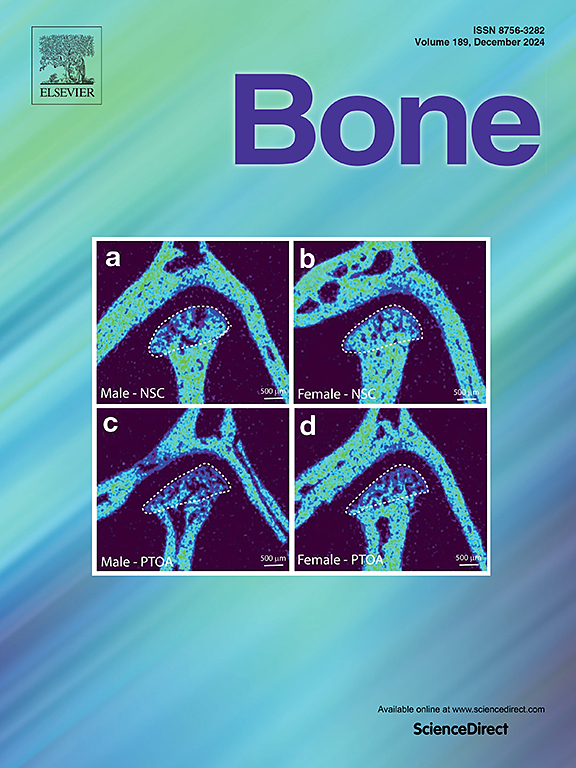韩国首次和第二次复发性骨质疏松性骨折的紧迫风险。
IF 3.5
2区 医学
Q2 ENDOCRINOLOGY & METABOLISM
引用次数: 0
摘要
背景:骨折史会增加继发和二次骨折的可能性。为预防进一步骨折,全球指南建议对有骨质疏松性骨折(OF)即决风险的患者进行积极主动的药物治疗,即在不久的将来极有可能发生继发性骨折。然而,在韩国却缺乏针对骨质疏松性骨折高危患者的研究。因此,本研究旨在评估韩国 OF 患者首次和第二次复发 OF 的紧迫风险:我们使用综合健康保险审查和评估数据库进行了一项回顾性分析,该数据库涵盖了 2012 年至 2017 年韩国的全部人口。研究的重点是 2013 年发生过 OF 的 55 岁及以上符合条件的患者,包括髋部/腰椎、脊椎、肱骨、桡骨、胫骨/腓骨和踝关节部位的骨折。2013 年发生的第一次 OF 被视为指数 OF。为确保指数骨折是指数骨折,我们排除了在指数骨折前一年内发生过任何指数骨折的患者。我们评估了指数 OF 发生后 2 年内首次复发 OF 的发生率,以及首次复发 OF 发生后 2 年内第二次复发 OF 的发生率。此外,我们还使用多变量考克斯比例危险回归分析法,根据年龄和性别估算了首次和第二次复发 OF 的风险:结果:约 17% 的首次 OF 患者在首次 OF 发生后 2 年内首次复发 OF。在首次复发 OF 的患者中,28% 的患者在首次复发 OF 后两年内再次发生 OF。首次复发 OF 的两年发病率为每 100 人年 9.6 例(95% 置信区间 [CI],9.6-9.7)。第二次复发的两年发病率为每百人年 22.0 例(95% 置信区间为 21.6-22.4),高于第一次复发的两年发病率。与男性相比,女性首次复发 OF 的风险高 31%(危险比 [HR] = 1.31;95 % CI,1.20-1.43),第二次复发 OF 的风险高 43%(HR = 1.43;95 % CI,1.35-1.51):结论:在韩国,第二次OF复发的直接风险高于第一次OF复发的风险。结论:在韩国,第二次复发 OF 的紧迫风险高于第一次复发 OF,因此,考虑到复发 OF 的次数越多,继发骨折的风险越高,建议对第一次复发 OF 的患者采取更有针对性的治疗方法。本文章由计算机程序翻译,如有差异,请以英文原文为准。
Imminent risk of the first and second recurrent osteoporotic fractures in South Korea
Background
A history of fractures increases the likelihood of experiencing subsequent and secondary fractures. To prevent further fractures, global guidelines recommend aggressive proactive treatment with medication for patients at an imminent risk of osteoporotic fracture (OF), which is defined as a high likelihood of experiencing subsequent fractures in the near future. However, there is a lack of research focusing on patients with imminent risk of OFs in South Korea. Hence, this study aimed to evaluate the imminent risk of the first and second recurrent OFs among patients with OF in South Korea.
Methods
We conducted a retrospective analysis using the comprehensive Health Insurance Review and Assessment database, which encompasses the entire population of Korea from 2012 to 2017. The study focused on eligible patients aged 55 years and older who experienced an OF in 2013, including fractures in the hip/femur, vertebral, humerus, radius, tibia/fibula, and ankle regions. The first OF occurring in 2013 was considered the index OF. To ensure that the index fracture was the index OFs, we excluded patients who had any OF within 1 year before their index OF. We assessed the incidence of the first recurrent OF within 2 years after the index OF, and the second recurrent OF within 2 years after the occurrence of the first recurrent OF. Additionally, we estimated the risks of experiencing the first and second recurrent OFs according to age and sex using multi-variable Cox proportional hazard regression analysis.
Results
Approximately 17 % of patients with an index OF had the first recurrent OF within 2 years after the index OF. Of those with a first recurrent OF, 28 % experienced a second recurrent OF within 2 years after the first recurrent OF. The two-year incidence rate of the first recurrent OF was 9.6 per 100 person-years (95 % confidence interval [CI], 9.6–9.7). The two-year incidence rate of the second recurrent OF was 22.0 per 100 person-years (95 % CI, 21.6–22.4), which is higher than that of the first recurrent OF. Females had a 31 % higher risk of the first recurrent OF (hazard ratio [HR] = 1.31; 95 % CI, 1.20–1.43) and a 43 % higher risk of the second recurrent OF than males (HR = 1.43; 95 % CI, 1.35–1.51).
Conclusions
In Korea, the imminent risk of a second recurrent OF was higher than that of a first recurrent OF. Consequently, given the elevated risk of subsequent fractures with the number of OFs experienced, a more targeted approach to treatment is recommended for patients with a first recurrent OF considering the risk of subsequent OF.
求助全文
通过发布文献求助,成功后即可免费获取论文全文。
去求助
来源期刊

Bone
医学-内分泌学与代谢
CiteScore
8.90
自引率
4.90%
发文量
264
审稿时长
30 days
期刊介绍:
BONE is an interdisciplinary forum for the rapid publication of original articles and reviews on basic, translational, and clinical aspects of bone and mineral metabolism. The Journal also encourages submissions related to interactions of bone with other organ systems, including cartilage, endocrine, muscle, fat, neural, vascular, gastrointestinal, hematopoietic, and immune systems. Particular attention is placed on the application of experimental studies to clinical practice.
 求助内容:
求助内容: 应助结果提醒方式:
应助结果提醒方式:


